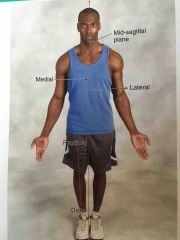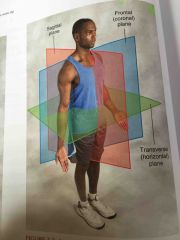![]()
![]()
![]()
Use LEFT and RIGHT arrow keys to navigate between flashcards;
Use UP and DOWN arrow keys to flip the card;
H to show hint;
A reads text to speech;
31 Cards in this Set
- Front
- Back
|
Kinesiology |
Study of mechanics of human movement and specifically evaluates muscles, joints and skeletal structures and their involvement in movement |
|
|
Biomechanics |
Study of motion and causes of motion of living things |
|
|
Kinesiology includes the study of: |
Gait, posture and body alignment, sports and exercise movements and activities of daily living and work |
|
|
Kinesiology is primarily based on three fields of science: |
1. Biomechanics 2. Musculoskelatal anatomy 3. Neuromuscular physiology |
|
|
Anatomical position: |

Body erect, feet together, upper limbs at sides, palms facing forward, thumbs facing away from body & fingers extended |
|
|
Three planes of body: |

1. Sagittal 2. Frontal 3. Transverse |
|
|
The sagittal plane divides the body into: |
Right and left sides |
|
|
The frontal plane divides the body into: |
Anterior and posterior portions |
|
|
The transverse plane divides the body into: |
Superior and inferior portions |
|
|
Anterior |
Front of body; ventral |
|
|
Posterior |
Back of body; dorsal |
|
|
Superficial |
Located close to or on body surface |
|
|
Deep |
Below the surface |
|
|
Proximal |
Closer to any reference point |
|
|
Distal |
Farther from any reference point |
|
|
Superior |
Toward the head; higher (cephalic) |
|
|
Inferior |
Away from the head; lower (caudal) |
|
|
Medial |
Toward the midline of the body |
|
|
Lateral |
Away from the midline of the body; to the side |
|
|
Ipsilateral |
On the same side |
|
|
Contralateral |
On the opposite side |
|
|
Unilateral |
One side |
|
|
Bilateral |
Both sides |
|
|
Prone |
Lying face down |
|
|
Supine |
Lying face up |
|
|
Valgus |
Distal segment of a joint deviates laterally |
|
|
Varus |
Distal segment of a joint deviates medially |
|
|
Arm |
Region from shoulder to elbow |
|
|
Forearm |
Region from elbow to wrist |
|
|
Thigh |
Region from hip to knee |
|
|
Leg |
Region from knee to ankle |

